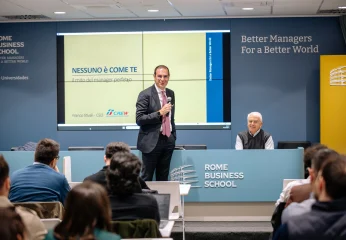Rome Business School study in collaboration with Legambiente

Next Generation EU / Italy: starting from urban centers for the sustainability of the 74 million euros destined for ecological reconversion
Trento, Mantua, Pordenone, Bolzano and Reggio Emilia are the areas best prepared to lead an ecological reconversion.
- Renewable sources currently cover more than 32% of the national electricity needs and 15% overall thanks to a mix of 700,000 plants from renewable sources spread across 100% of Italian municipalities.
- The Report, prepared by Rome Business School and the environmental association Legambiente, highlights a two-speed Italy.
Wednesday 27 January 2020. – Rome Business School, in collaboration with Legambiente, published the study: “Environmental sustainability and sustainable development. What challenges for the urban ecosystem of the future? ” (edited by Valerio Mancini, Director of the Rome Business School Research Center, and by Mattia Lolli, member of the National Secretariat of Legambiente) who presents the results of a survey on 104 municipalities in the capital of Italy, highlighting significant critical issues and numerous environmental performances poor or bad:
“It is a two-speed Italy: the first is more dynamic and attentive to new urban planning choices, to mobility services, to renewable sources, to the progressive restitution of public spaces to citizens, to the growth of natural areas. The second, more static with a too “slow” trend in the environmental performance of metropolises, especially in terms of smog, transport, separate collection and water management “, explain the authors.
The cities of Trento, Mantua, Pordenone, Bolzano and Reggio Emilia at the top of the general classification testify to this; At the bottom of the ranking we find: Pescara (102nd), Palermo (103rd) and Vibo Valentia (104th).
In general, large centers struggle to respond to the critical issues that characterize them. An exception is Milan (29th), which has been increasingly attentive in recent years to sustainable mobility and, in general, to respect for the environment. The Lombard capital, in fact, is the only large city to have a water network that loses much less than 25% of the water fed into the network: fourth overall with just 13.7% losses (it was 15.2% last year).
The data collected relating to the Italian regions most attentive to the green economy show that Lombardy is the most active in energy efficiency, circular economy processes and, in general, in initiatives and projects to reduce environmental impact. Then follow Lazio, Piedmont, and Tuscany; the rear of this green ranking is the Aosta Valley which, however, has one of the highest initiative rates.
The study photographs the change that is going through Italy, an energy revolution that now leads renewable sources to cover over 32% of the national electricity needs and 15% overall thanks to a mix of 700 thousand plants from renewable sources spread in 100%. of Italian Municipalities.
But the challenge is concrete: “In Italy, the fossil sources used to meet the needs of electricity and heat, such as coal, oil and gas, are responsible for 24% of climate-altering emissions. To these are added those generated by transport, to which another 24% goes, those related to the residential and commercial sector for 17%, those in the industrial sector with 11% and the agricultural sector with 9% “.
The research then presents some concrete proposals for a sustainable use of the resources of the Next Generation EU including the construction of 170 major works ranging from the reclamation and safety of the groundwater, the plants to treat the differentiated staff, the railway nodes and reclamation of large areas of public interest.




